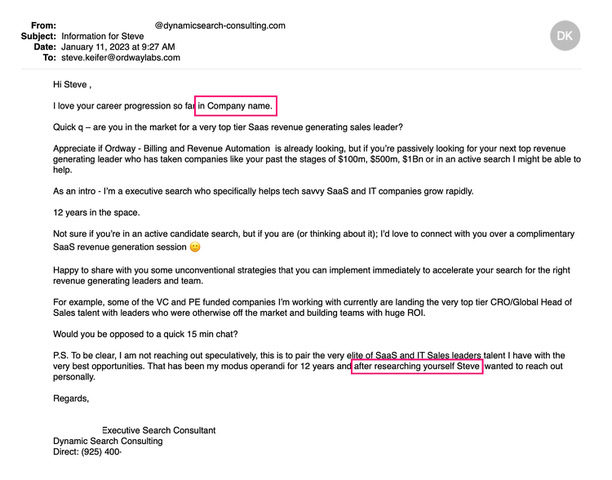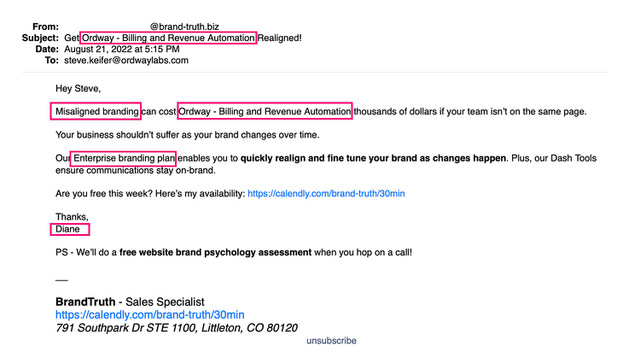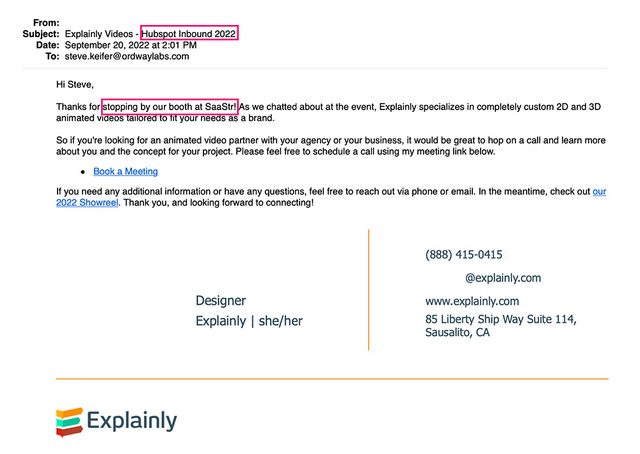Neither the Sender nor the Receiver Read the Email
Every day millions of automated emails are sent out by BDRs and sales reps who are trying to find buyers for their products. The teams that send the emails don’t expect most of them to be read. In fact, if they get a 1% response rate to these types of prospecting emails, the sales rep will be thrilled.

But over the past few years, there’s been a big change in sales prospecting emails. Today, it is no longer just the recipients (customers) that only read 1% of the emails. The senders (sales reps) don’t read the emails either! In most cases, the BDRs don’t even know that the automated emails are being sent out under their name.
These emails are being scheduled by a Revenue Operations manager on behalf of sales using prospecting technologies such as Outreach or Salesloft. With modern sales technology you can not only can you send out a high volume of emails, but you can mass customize them as well – creating the illusion that they are personalized.
The Magic of Mass Personalization
The underlying magic is the use of variables. Let’s say you were targeting Clark Kent, the famous reporter from the Daily Planet. The prospecting software could look up clark.kent@dailyplanet.com and identify Clark’s first name, job title, company name, and other firmographic details to insert in the email creating a more personalized message.
The email appears:
Hi Clark,
Carrying two jobs as a reporter for the Daily Planet and our favorite Superhero, you must have a real challenge keeping the world safe from criminals, villains, and other evildoers that are out to do harm. Our bad guy tracking system can auto-magically alert you to the whereabouts and plans of mischievous thugs around the world, enabling you to focus more time on journalism and less time worrying about saving the world.
Lex
Although it appears personalized, it was actually sent to dozens of other business leaders around the world including Bruce Wayne, Tony Stark, etc. The raw email template, titled Secret Superhero email #6, is:
Hi {First Name},
Carrying two jobs as a {Job title 1} for {Company Name 1} and {Job Title 2}, you must have a real challenge {Buyer persona challenge}. Our bad guy tracking system can auto-magically alert you to the whereabouts and plans of mischievous thugs around the world, enabling you to focus more time on journalism and less time worrying about saving the world.
{Sender Name}
But what happens when the variable data fields are populated incorrectly or not populated at all? An email is distributed that doesn’t make any sense. Here’s an example.
Hi Tony,
As the editor-in-chief for the Daily Planet and our favorite Villain you must have a real challenge keeping the world safe from criminals, villains, and other evildoers that are out to do harm. Our bad guy tracking system can auto-magically alert you to the whereabouts and plans of mischievous thugs around the world, enabling you to focus more time on journalism and less time worrying about saving the world.
The Joker
Real World of Examples
Automated Emails with Mismatched Variables
I actually open up 80% of the emails I get from BDRs. Why? Because I’m always looking for new strategies to pitch decision makers over email that I can use with my BDR team. One thing I have observed is a steady increase in the volume of emails with incorrect variables over the past few years. Because the emails are automated, no one knows when these errors occur. The sales reps whose names appear in the sender field don’t see the emails before they go out. The rev ops teams that schedule the emails don’t review them either. It’s only the 1% of recipients that bother to read them are the only ones likely to notice.
I’ve included some examples of really bad emails I’ve received over the past few months. My goal in sharing these real-world messages is not to embarrass the sales reps who sent them. In fact, I’ve whited out the names of the individuals who sent them. They probably don’t even know they sent me an email. The goal is to point out that outbound email automation is increasingly growing out of control. As the volume of automated emails have increased so has the percentage which have embarrassing mistakes.
No Company Name
Selling personalized recruiting services to a company whose name you don’t know
Below is an email from a contingent executive search consultant trying to place a Chief Revenue Officer who is looking for a job. Note the first sentence “I love your career progression so far in Company name…after researching yourself Steve wanted to reach out personally.” The company name was not populated by the automated email sequence, presumably because it was unavailable.
Wrong Company/Email Address
Pitching your former employer services at your current email address
Another common example involves mixing up companies and emails. Below is an example from a company selling a marketing database for IT security leads. Note the subject line refers to a former employer (ID.me), but the email is sent to the email domain of my current employer (Ordway). The wrong variables were populated by the automated email sequence. My current company sells billing software to CFOs and has no interest in purchasing a list of security software users.
The irony is that this vendor is selling a contact database for which the primary value would be an accurate list of companies and email addresses. However, they are unable to get my company and email address correct.
Why did this happen? The Rev Ops manager that setup the campaigned selected all CMOs that worked (past & present) at cybersecurity vendors. They should have only pulled CMOs that worked (present) at cybersecurity vendors.
This was honest mistake, right? It doesn’t happen very often. Except that it does! I’ve received several dozen of these in 2022. Here is another example of an email to sent to my email address at my current employer referencing jobs I had 3 years ago!
Note that this one is from Apollo.io who is one of the leading vendors in the marketing contact database space. Would you buy contact data from a sales intelligence platform doesn’t know what company you work for?
Sales Doesn’t Care if the Email is Correct
The goal is to get your attention. Right or wrong doesn’t matter!
I wrote back to a few of these SDRs and pointed out the error in their emails. The response I got from each of them was a quick mea acupla “Yeah, it was an automated email someone else set up” and then they tried to pitch me.
In today’s highly automated sales process, it no longer matters if the information you are sending is correct. The thinking is “If I can get your attention and a response then I was successful.” But can you really expect to book a discovery call with someone when you get their name, job title, or company name wrong?
Wrong Company Name
Pitching branding services with wrong company name
Here’s an example of a company trying to pitch me branding services, but they cannot get my company name right:
“Misaligned branding can cost Ordway – Billing and Revenue Automation thousands of dollars if your team isn’t on the same page.”
The company name should be “Ordway,” not “Ordway – Billing and Revenue Automation.” The source of the error is likely from LinkedIn. We deliberately listed the company name along with a description so that people know what we do. Does pitching a CMO a branding service while using their company name incorrectly really work?
Wrong Content Reference
Selling fresh content services with outdated content
Below is another example from a marketing agency. This sales rep is trying to sell lead generation services to companies running Hubspot’s marketing platform. They went to a sales intelligence service such as ZoomInfo and pulled a list of companies using Hubspot along with recent product release announcements. The sales prospecting software automatically pulls the keywords from the press release headline and inserts it into the email before sending. The problem is that in this case, the email sent in January 2023 references a product announcement from August 2021 (almost 18 months earlier).
This rep claims they’ve helped other companies with lead generation by “reviving their unengaged databases with fresh content and effective automations.” Does sending stale news references in a campaign about “fresh content” really work?
Marketing Should Care if the Emails are Incorrect
Bad Emails lead to Spam, Deliverability, and Sender Reputation Challenges
While sales may not care if the emails are incorrect, marketing should. This is how you end up in the spam folder. Most people who open an irrelevant message will immediately block the sender, mark it as spam, or delete without reading. Incorrect messages impact email deliverability and your sender reputation. But marketing leaders face a challenge in policing bad prospecting messages. If the sales reps don’t see the emails before they go out, how can the marketing team? Sales automation vendors don’t make it easy to review sent emails and look for these types of mistakes. It’s easier to get a live phone conversation with a customer service rep then it is to view outbound emails.
Wrong Campaign Subject Line
Following up on a tradeshow you never went to
Not all of the bad emails are the result of automation. Humans make mistakes too. In September, I attended the SaaStr conference and interfaced with this vendor, which creates really good animated videos. The same vendor also exhibited the week before at the Hubspot Inbound show. The sales team returned from SaaStr, loaded up the lead list, and then cloned the email sequence used to follow up on the Inbound show. Not a bad idea except they didn’t bother to proofread the email subject line, which references “Hubspot Inbound.” As a result, hundreds of SaaStr recipients receive an email about attending “Hubspot Inbound 2022” and are understandably confused. It’s unlikely that many people attended both since they were on back-to-back weeks in Boston and San Francisco. This vendor sent not just one email with Hubspot in the subject line, but four or five.















